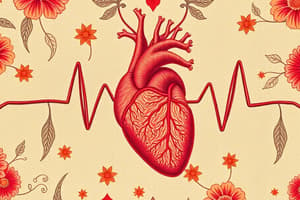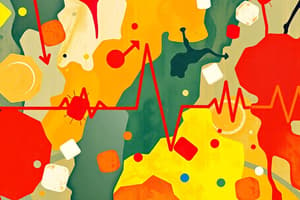Podcast
Questions and Answers
What is the main effect of Class 3 antiarrhythmic drugs?
What is the main effect of Class 3 antiarrhythmic drugs?
- Prolongs phase 3 repolarization (correct)
- Blocks sodium channels
- Increases calcium ion influx
- Decreases heart rate
Name one Class 3 antiarrhythmic drug.
Name one Class 3 antiarrhythmic drug.
Amiodarone
Which drugs are classified as Class 4 antiarrhythmics?
Which drugs are classified as Class 4 antiarrhythmics?
- Dronedarone, Procainamide
- Amiodarone, Sotalol
- Verapamil, Diltiazem (correct)
- Ibutilide, Dofetilide
Sotalol has both β-blocking and action potential prolonging actions.
Sotalol has both β-blocking and action potential prolonging actions.
Amiodarone can cause adverse effects on the ______, ______, and ______.
Amiodarone can cause adverse effects on the ______, ______, and ______.
What is the primary action of non-dihydropyridine (NDHP) drugs?
What is the primary action of non-dihydropyridine (NDHP) drugs?
Dihydropyridine (DHP) drugs primarily affect the ______.
Dihydropyridine (DHP) drugs primarily affect the ______.
What is the mechanism of action of Verapamil?
What is the mechanism of action of Verapamil?
What is the clinical application of Adenosine?
What is the clinical application of Adenosine?
What is the therapeutic use of Magnesium in relation to arrhythmias?
What is the therapeutic use of Magnesium in relation to arrhythmias?
Atropine is used to treat bradycardia by producing a vagal block to increase heart rate.
Atropine is used to treat bradycardia by producing a vagal block to increase heart rate.
Flashcards are hidden until you start studying
Study Notes
Class 3 Antiarrhythmic Drugs
- Potassium (K+) channel blockers, prolong phase 3 repolarization, increasing QT interval.
- Key drugs include Amiodarone, Ibutilide, Dofetilide, Dronedarone, and Sotalol (AIDDS).
- All can induce torsades de pointes; Amiodarone carries the lowest risk.
Class 4 Antiarrhythmic Drugs
- Calcium (Ca2+) channel antagonists affecting cardiac function.
- Causes decrease in SA nodal automaticity, AV nodal conduction, and ventricular contractility.
- Primary drugs: Verapamil and Diltiazem.
Amiodarone
- Multi-channel blocker impacting K+, Na+, and Ca2+.
- Adverse effects include pulmonary toxicity, thyroid dysfunction, and liver damage; monitoring required every 3 months.
Ibutilide and Dofetilide
- Class III K+ channel blockers indicated for atrial and ventricular arrhythmias.
- Specifically block the rapid component (IKr) of the delayed rectifier K+ current, slowing repolarization.
Sotalol
- Exhibits both β-blocking and action potential-prolonging properties.
Non-Dihydropyridine (NDHP) Drugs
- Includes Verapamil and Diltiazem, primarily affecting the heart.
- Induces vasodilation, resulting in lower blood pressure.
Dihydropyridine (DHP) Drug
- Nifedipine is the primary example, mainly targeting the vasculature.
- Not utilized as an antiarrhythmic agent.
Calcium Channel Blockers (CCBs)
- Have minimal impact on smooth muscle outside the cardiac context.
- Skeletal muscle is not affected under conventional CCB treatment.
- Reduce the responsiveness of Ca2+ channel pores to voltage depolarization.
Verapamil
- Mechanism of Action: Reduces SA automaticity leading to decreased heart rate; slows AV conduction, increasing PR interval.
- Ineffective on ventricular arrhythmias due to no impact on Na+ conduction.
- Clinical Uses: Prevention and conversion of nodal arrhythmias (PSVT), rate control in atrial fibrillation.
- Adverse Effects: Includes headache, flushing, dizziness, ankle edema, constipation, and potential exacerbation of heart failure.
- Contraindications: Sick sinus syndrome, pre-existing AV nodal disease, WPW syndrome with atrial fibrillation, ventricular tachycardia.
Adenosine
- Treats paroxysmal supraventricular tachycardia (PSVT), particularly reentry mechanisms involving accessory pathways.
- Extremely short half-life (10-15 seconds); administered IV to central vein.
- Activates A1 receptors in SA and AV nodes, opening K+ channels and facilitating K+ efflux.
- Also activates A2 receptors in vasculature, leading to nitric oxide (NO) release through endothelial Ca2+ modulation.
Magnesium
- Functions as a muscle relaxant.
- Mechanism of Action: Acts as a cofactor for ATP-dependent enzymes and inhibits calcium channels.
- Therapeutic Uses: Effective for torsades de pointes, perioperative atrial fibrillation, and digitalis-induced arrhythmias.
Atropine
- Utilized for bradycardia treatment.
- Functions by producing a vagal block to increase heart rate.
Studying That Suits You
Use AI to generate personalized quizzes and flashcards to suit your learning preferences.



